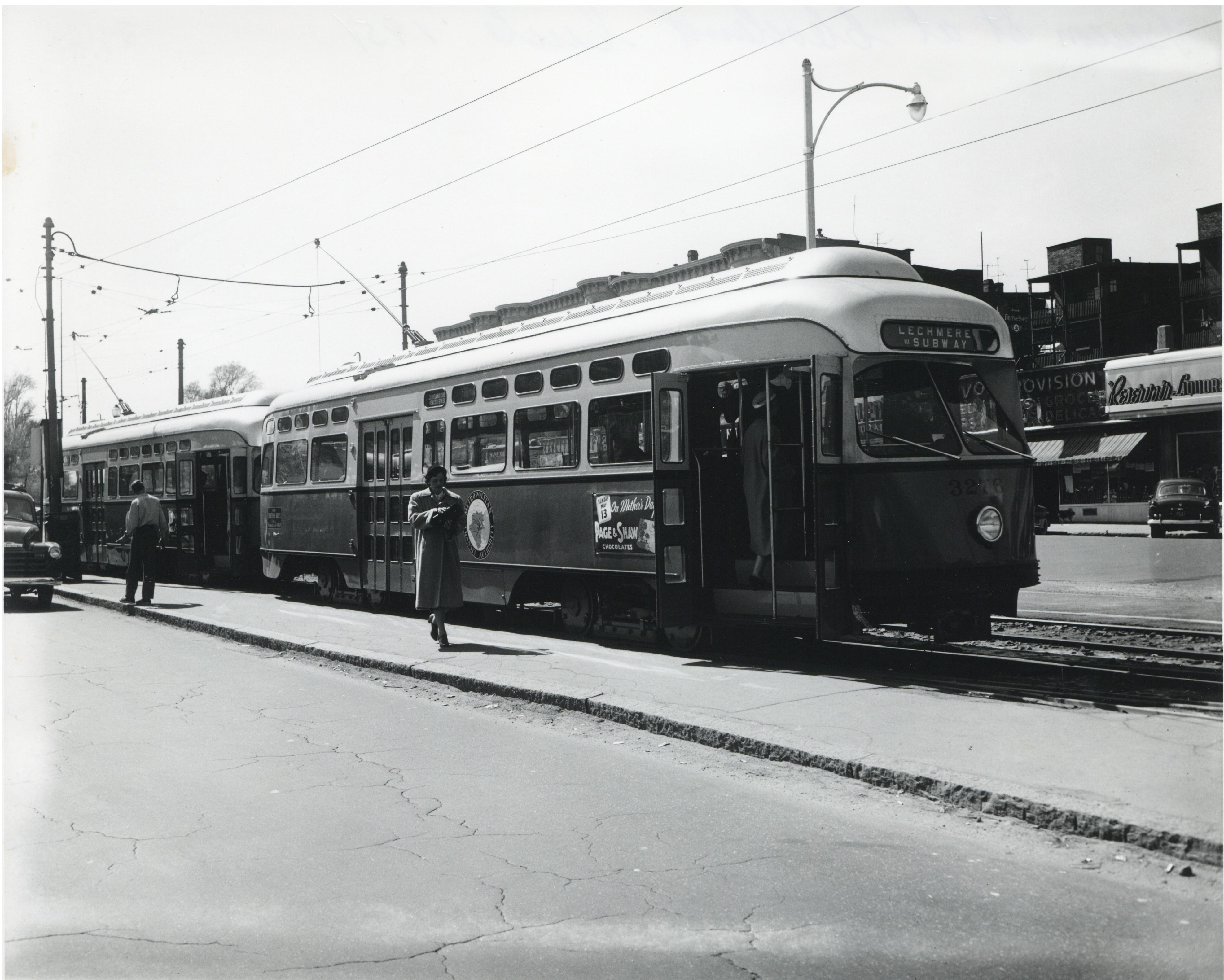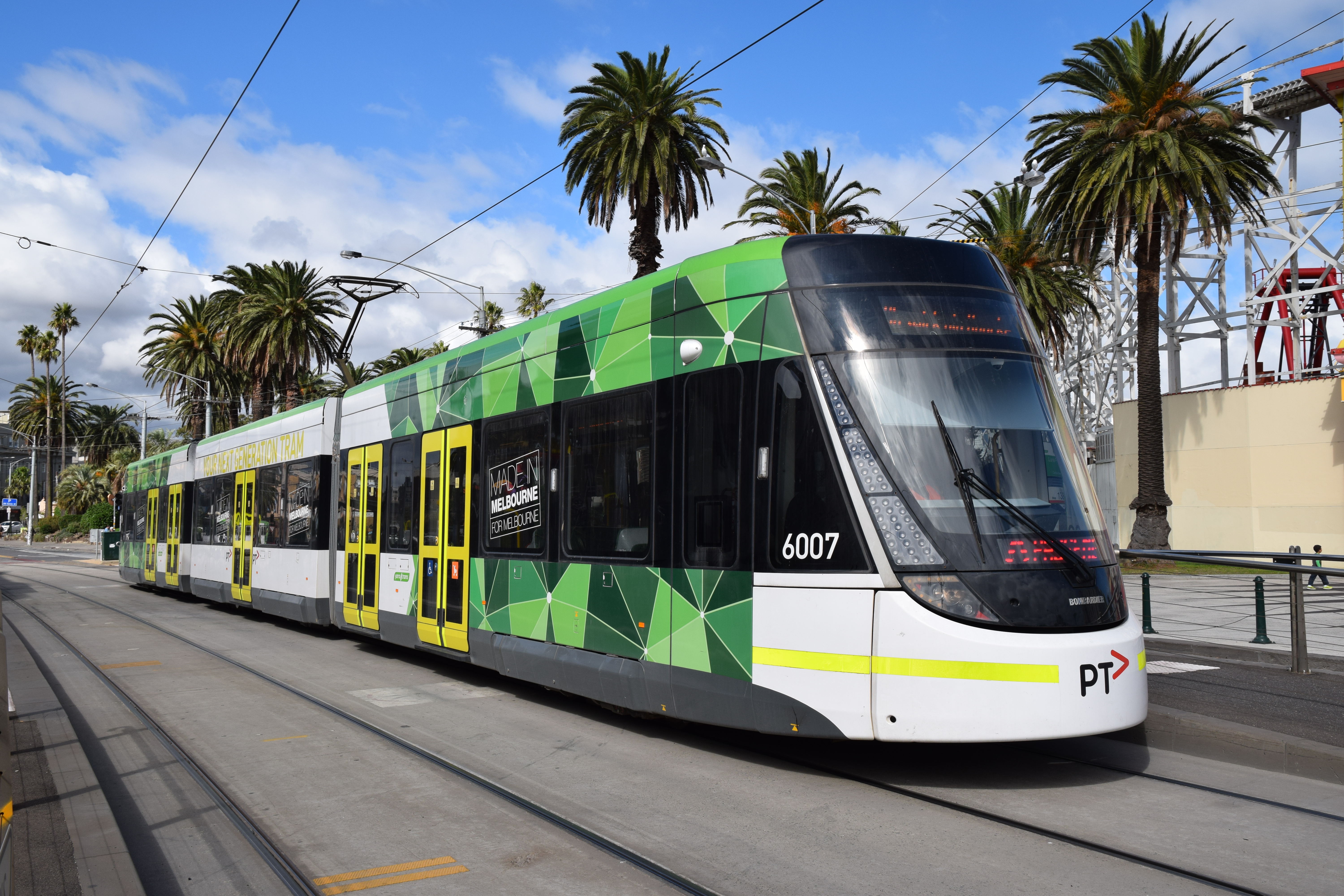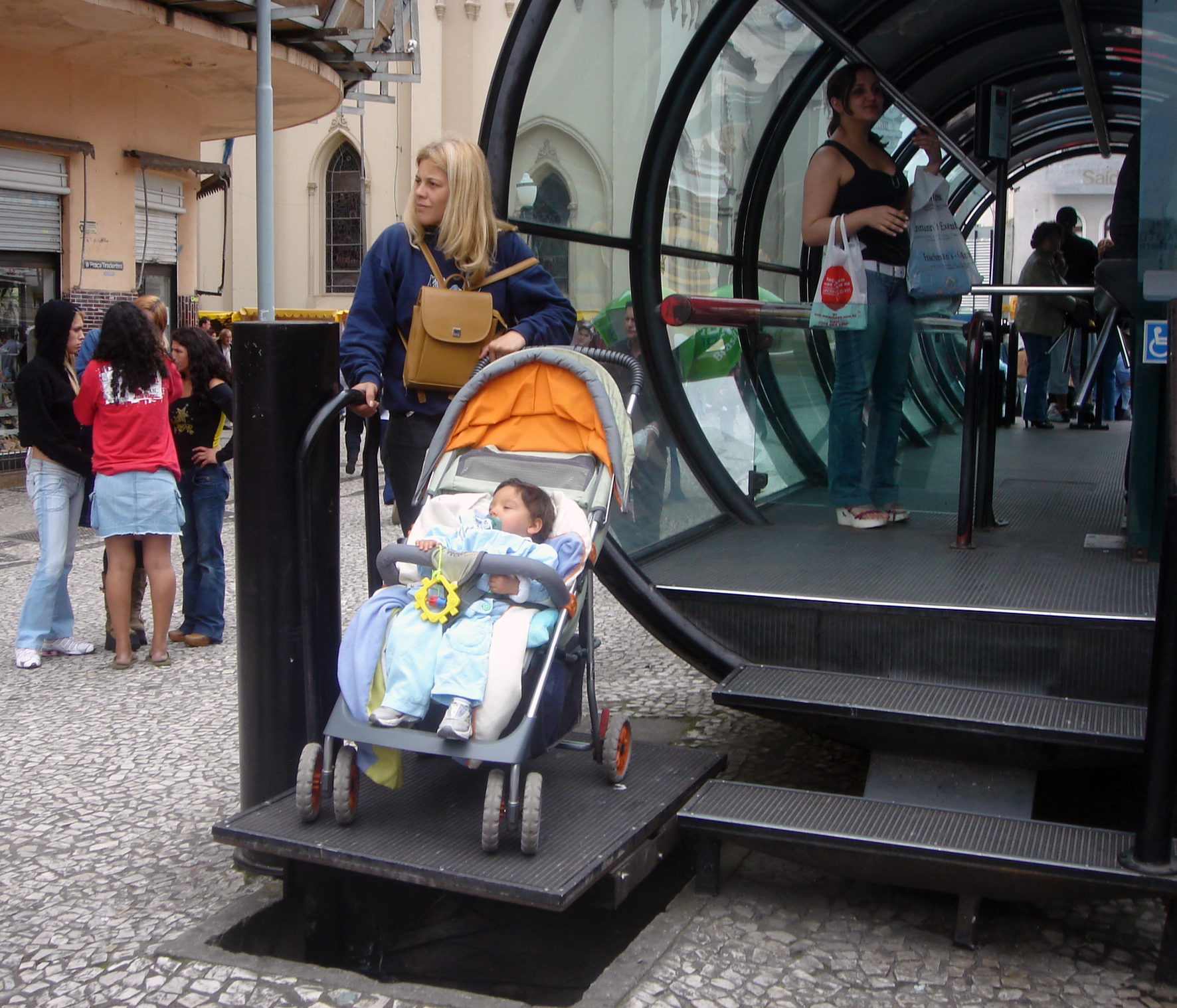|
Saint Mary's Street Station
Saint Mary's Street station is a surface light rail stop on the MBTA Green Line C branch, located just west of the intersection of Beacon Street and Park Drive in the northeastern tip of Brookline, Massachusetts. Like all surface stops on the line, Saint Mary's Street has two side platforms serving two tracks. The station is accessible. With just over 1,500 daily boardings by a 2011 count, Saint Mary's Street is the second-busiest stop on the C branch, behind only . History Saint Mary's Street is the first outbound surface stop on the C branch. The line emerges from the Beacon Street tunnel at the Saint Mary's Street portal, just east of the station. Until was built in 1932, streetcars emerged from the Kenmore portal and ran down the median of Beacon Street from Kenmore Square. In the early 2000s, the MBTA modified key surface stops with raised platforms for accessibility. Portable lifts were installed at Saint Mary's Street around 2000 as a temporary measure. The renovati ... [...More Info...] [...Related Items...] OR: [Wikipedia] [Google] [Baidu] |
Beacon Street
Beacon Street is a major thoroughfare in Boston, Massachusetts and its western suburbs Brookline and Newton. It passes through many of Boston's central and western neighborhoods, including Beacon Hill, Back Bay, Fenway–Kenmore, the Boston University campus, Brighton, and Chestnut Hill. It is not to be confused with the Beacon Street in nearby Somerville or others elsewhere. Description Beacon Street begins as a one-way street from the intersection of Tremont Street and School Street. From this point, it rises up Beacon Hill for a block where it meets Park Street in front of the Massachusetts State House. From that intersection it descends Beacon Hill as a two-lane, bi-directional street until it reaches Charles Street. At Charles Street, it becomes a one-way avenue that runs through the Back Bay neighborhood until it reaches Kenmore Square. From Kenmore Square, Beacon Street skirts the area around Fenway Park and follows a southwesterly slant through Brookline along ... [...More Info...] [...Related Items...] OR: [Wikipedia] [Google] [Baidu] |
Brookline, Massachusetts
Brookline is a town in Norfolk County, Massachusetts, in the United States, and part of the Boston metropolitan area. Brookline borders six of Boston's neighborhoods: Brighton, Allston, Fenway–Kenmore, Mission Hill, Jamaica Plain, and West Roxbury. The city of Newton lies to the west of Brookline. Brookline was first settled in 1638 as a hamlet in Boston, known as Muddy River; it was incorporated as a separate town in 1705. At the time of the 2020 United States Census, the population of the town was 63,191. It is the most populous municipality in Massachusetts to have a town (rather than city) form of government. History Once part of Algonquian territory, Brookline was first settled by European colonists in the early 17th century. The area was an outlying part of the colonial settlement of Boston and known as the hamlet of Muddy River. In 1705, it was incorporated as the independent town of Brookline. The northern and southern borders of the town were marked by t ... [...More Info...] [...Related Items...] OR: [Wikipedia] [Google] [Baidu] |
MBTA Bus
The Massachusetts Bay Transportation Authority (MBTA) operates 170 bus routes in the Greater Boston area. The MBTA has a policy objective to provide transit service within walking distance (defined as ) for all residents living in areas with population densities greater than within the MBTA's service district. Much of this service is provided by bus. In , the system had a ridership of , or about per weekday as of . Most MBTA bus routes are local service operated in Boston and its inner suburbs and connect to MBTA subway stations. Fifteen high-ridership local routes are designated as key routes, with higher frequency at all operating hours. The MBTA operates a five-route bus rapid transit service branded as the Silver Line, as well as two limited-stop crosstown routes. Three smaller local networks are based in the nearby cities of Lynn, Waltham, and Quincy. Several express routes operate from suburbs to downtown Boston. The MBTA has an active bus fleet around 1,140 buses ... [...More Info...] [...Related Items...] OR: [Wikipedia] [Google] [Baidu] |
Side Platform
A side platform (also known as a marginal platform or a single-face platform) is a railway platform, platform positioned to the side of one or more railway tracks or guideways at a railway station, tram stop, or bus rapid transit, transitway. A station having dual side platforms, one for each direction of travel, is the basic design used for double-track railway lines (as opposed to, for instance, the island platform where a single platform lies between the tracks). Side platforms may result in a wider overall footprint for the station compared with an island platform where a single width of platform can be shared by riders using either track. In some stations, the two side platforms are connected by a footbridge running above and over the tracks. While a pair of side platforms is often provided on a dual-track line, a single side platform is usually sufficient for a single-track line. Layout Where the station is close to a level crossing (grade crossing) the platforms may ei ... [...More Info...] [...Related Items...] OR: [Wikipedia] [Google] [Baidu] |
MBTA
The Massachusetts Bay Transportation Authority (abbreviated MBTA and known colloquially as "the T") is the public agency responsible for operating most public transportation services in Greater Boston, Massachusetts. The MBTA transit network includes the MBTA subway with three metro lines (the Blue, Orange, and Red lines), two light rail lines (the Green and Ashmont–Mattapan lines), and a five-line bus rapid transit system (the Silver Line); MBTA bus local and express service; the twelve-line MBTA Commuter Rail system, and several ferry routes. In , the system had a ridership of , or about per weekday as of , of which the rapid transit lines averaged and the light rail lines , making it the fourth-busiest rapid transit system and the third-busiest light rail system in the United States. As of , average weekday ridership of the commuter rail system was , making it the sixth-busiest commuter rail system in the U.S. The MBTA is the successor of several previous public ... [...More Info...] [...Related Items...] OR: [Wikipedia] [Google] [Baidu] |
Green Line (MBTA)
The Green Line is a light rail system run by the Massachusetts Bay Transportation Authority (MBTA) in the Boston, Massachusetts, metropolitan area. It is the oldest MBTA subway line, and with tunnel sections dating from 1897, the oldest subway in North America. It runs underground through downtown Boston, and on the surface into inner suburbs via six branches on radial boulevards and grade-separated alignments. With an average daily weekday ridership of 137,700 in 2019, it is the third most heavily used light rail system in the country. The line was assigned the green color in 1967 during a systemwide rebranding because several branches pass through sections of the Emerald Necklace of Boston. The four branches are the remnants of a large streetcar system, which began in 1856 with the Cambridge Horse Railroad and was consolidated into the Boston Elevated Railway several decades later. The branches all travel downtown through the Tremont Street subway, the oldest subway tunnel ... [...More Info...] [...Related Items...] OR: [Wikipedia] [Google] [Baidu] |
Green Line C Branch
The C branch, also called the Beacon Street Line or Cleveland Circle Line, is one of four branches of the Massachusetts Bay Transportation Authority's Green Line light rail system in the Boston, Massachusetts metropolitan area. The line begins at Cleveland Circle in the Brighton neighborhood of Boston and runs on the surface through Brookline along the median of Beacon Street. Reentering Boston, the line goes underground through the St. Mary's Street incline and joins the B and D branches at Kenmore. Trains run through the Boylston Street subway to Copley where the E branch joins, then continue through the Tremont Street subway to downtown Boston. The C branch has terminated at Government Center station since October 2021. , service operates on 7.5 minute headways at weekday peak hours and 9 to 10-minute headways at other times, using 8 to 12 trains (16 to 24 LRVs). History The first tracks on Beacon Street were laid in 1888, running from Massachusetts Avenue west to C ... [...More Info...] [...Related Items...] OR: [Wikipedia] [Google] [Baidu] |
MBTA Accessibility
The Massachusetts Bay Transportation Authority (MBTA) system is mostly but not fully accessible. Like most American mass transit systems, much of the MBTA subway and commuter rail were built before wheelchair access became a requirement under the Americans with Disabilities Act of 1990. The MBTA has renovated most stations to be compliant with the ADA, and all stations built since 1990 are accessible. The MBTA also has a paratransit program, The Ride, which provides accessible vehicles to transport passengers who cannot use the fixed-route system. Much of the MBTA subway system is accessible: all Orange and Red Line stations, and all but one Blue Line station, are accessible. Most of the underground portion of the Green Line is accessible, though only some surface stops are; all but one stop on the Ashmont–Mattapan High-Speed Line are accessible. About three-quarters of the MBTA Commuter Rail system is accessible, including the North Station and South Station terminals. ... [...More Info...] [...Related Items...] OR: [Wikipedia] [Google] [Baidu] |
Streetcar Entering Saint Marys Street Portal, 1932
A tram (called a streetcar or trolley in North America) is a rail vehicle that travels on tramway tracks on public urban streets; some include segments on segregated right-of-way. The tramlines or networks operated as public transport are called tramways or simply trams/streetcars. Many recently built tramways use the contemporary term light rail. The vehicles are called streetcars or trolleys (not to be confused with trolleybus) in North America and trams or tramcars elsewhere. The first two terms are often used interchangeably in the United States, with ''trolley'' being the preferred term in the eastern US and ''streetcar'' in the western US. ''Streetcar'' or ''tramway'' are preferred in Canada. In parts of the United States, internally powered buses made to resemble a streetcar are often referred to as "trolleys". To avoid further confusion with trolley buses, the American Public Transportation Association (APTA) refers to them as "trolley-replica buses". In the United ... [...More Info...] [...Related Items...] OR: [Wikipedia] [Google] [Baidu] |
Accessibility
Accessibility is the design of products, devices, services, vehicles, or environments so as to be usable by people with disabilities. The concept of accessible design and practice of accessible development ensures both "direct access" (i.e. unassisted) and "indirect access" meaning compatibility with a person's assistive technology (for example, computer screen readers). Accessibility can be viewed as the "ability to access" and benefit from some system or entity. The concept focuses on enabling access for people with disabilities, or enabling access through the use of assistive technology; however, research and development in accessibility brings benefits to everyone. Accessibility is not to be confused with usability, which is the extent to which a product (such as a device, service, or environment) can be used by specified users to achieve specified goals with effectiveness, efficiency, convenience, or satisfaction in a specified context of use. Accessibility is also s ... [...More Info...] [...Related Items...] OR: [Wikipedia] [Google] [Baidu] |
Wheelchair Lift
A wheelchair lift, also known as a platform lift, or vertical platform lift, is a fully powered device designed to raise a wheelchair and its occupant in order to overcome a step or similar vertical barrier. Wheelchair lifts can be installed in homes or businesses and are often added to both private and public vehicles in order to meet accessibility requirements laid out by disability acts. These mobility devices are often installed in homes as an alternative to a stair lift, which only transport a passenger and not his/her wheelchair or mobility scooter. Regulations In the United States, the Americans with Disabilities Act of 1990 (ADA) required that all new mass transit vehicles placed into service after July 1, 1993, be accessible to persons in wheelchairs,"Getting on board" (July–August 1993). ''Trolleybus Magazine'' No. 190, pp. 86–87. National Trolleybus Association (UK). . and until the 2000s, this requirement was most commonly met by the inclusion of a whee ... [...More Info...] [...Related Items...] OR: [Wikipedia] [Google] [Baidu] |






